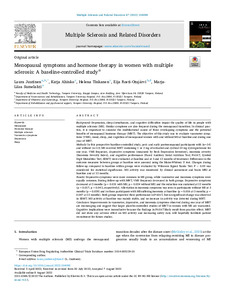Menopausal symptoms and hormone therapy in women with multiple sclerosis : A baseline-controlled study
Juutinen, Laura; Ahinko, Katja; Tinkanen, Helena; Rosti-Otajärvi, Eija; Sumelahti, Marja Liisa (2022)
Juutinen, Laura
Ahinko, Katja
Tinkanen, Helena
Rosti-Otajärvi, Eija
Sumelahti, Marja Liisa
2022
104098
Julkaisun pysyvä osoite on
https://urn.fi/URN:NBN:fi:tuni-202209137007
https://urn.fi/URN:NBN:fi:tuni-202209137007
Kuvaus
Peer reviewed
Tiivistelmä
Background: Depression, sleep disturbances, and cognitive difficulties impair the quality of life in people with multiple sclerosis (MS). Similar symptoms are also frequent during the menopausal transition. In clinical practice, it is important to consider the multifactorial causes of these overlapping symptoms and the potential benefits of menopausal hormone therapy (MHT). The objective of this study was to evaluate vasomotor symptoms (VMS), mood, sleep, and cognition of menopausal women with and without MS at baseline and during one year of MHT. Methods: In this prospective baseline-controlled study, peri- and early postmenopausal participants with (n=14) and without (n=13) MS received MHT containing 1 or 2 mg of estradiol and cyclical 10 mg dydrogesterone for one year. VMS frequency, depressive symptoms (measured by Beck Depression Inventory), insomnia severity (Insomnia Severity Index), and cognitive performance (Paced Auditory Serial Addition Test; PASAT, Symbol Digit Modalities Test; SDMT) were evaluated at baseline and at 3 and 12 months of treatment. Differences in the outcome measures between groups at baseline were assessed using the Mann-Whitney U test. Changes during follow-up compared to baseline within groups were evaluated by Wilcoxon Signed Ranks Test. P < 0.05 was considered for statistical significance. MS activity was monitored by clinical assessment and brain MRI at baseline and at 12 months. Results: Depressive symptoms were more common in MS group, while vasomotor and insomnia symptoms were equally common. During follow-up with MHT, VMS frequency decreased in both groups. Depressive symptoms decreased at 3 months (p = 0.031 with MS; p = 0.024 without MS) and the reduction was sustained at 12 months (p = 0.017; p = 0.042, respectively). Alleviation in insomnia symptoms was seen in participants without MS at 3 months (p = 0.029) and in those participants with MS suffering insomnia at baseline (p = 0.016 at 3 months; p = 0.047 at 12 months). Both groups improved their performance in PASAT, but no significant change was observed in SDMT. MS activity at baseline was mainly stable, and no increase in activity was detected during MHT. Conclusion: Improvements in vasomotor, depressive, and insomnia symptoms observed during one year of MHT are encouraging and suggest that larger placebo-controlled studies of MHT in women with MS are warranted. Cognitive implications were inconclusive because the findings in PASAT likely result from practice effect. MHT did not show any adverse effect on MS activity and increasing safety data will hopefully facilitate patient recruitment for future studies.
Kokoelmat
- TUNICRIS-julkaisut [16929]
